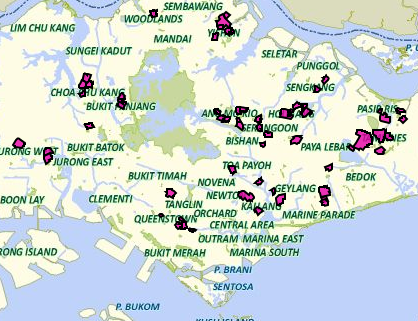(原文掲載日は6月13日です)
2012年シンガポールでは4,632件のデング熱患者数を記録した。今年その数はすでに9,847件に上った. 直近で2005年にデング熱の大流行を記録したシンガポールにとってこれは最高記録である。
全国環境庁(NEA)はデング熱防止の認識を促進するため「蚊を全滅させろ」という運動を始めた。
Singapore cannot fight dengue without the community’s action to remove mosquito breeding in their homes. The Aedes mosquito breeds in artificial containers mainly found in homes, and its life-cycle averages seven days. Hence it is imperative for all to do the Mozzie Wipeout together to break the breeding cycle.
シンガポールは、地域社会が住宅で繁殖する蚊を駆除する取り組みを行うことなくしてデング熱と戦うことはできない。ヤブカは主に、家庭で見られるような人工的な容器で繁殖し、寿命は平均して7日間である。それゆえに、繁殖する周期を壊すため協力して「蚊を全滅させろ」という運動をすることは私たちにとって必要不可欠である。
 デング熱の情報サイトを管理することに加えて、NEAはFacebookページも持っている。政府と地域社会によるデング熱と戦う取組みを一般の人々に啓発するためだ。また、デング熱の症例を集団に分類するために地図作成システムを使用している。
デング熱の情報サイトを管理することに加えて、NEAはFacebookページも持っている。政府と地域社会によるデング熱と戦う取組みを一般の人々に啓発するためだ。また、デング熱の症例を集団に分類するために地図作成システムを使用している。
A dengue cluster is formed when 2 or more dengue cases occur within 14 days and the homes of the dengue victims are within the distance of 150m.
デング熱の集団は、14日以内に2件以上のデング熱の症例が発生していて、デング熱感染者の家が150m圏内にある場合に形成される。
ミヤギ氏は読者に、建設現場がデング熱ウイルスを運ぶ蚊の唯一の温床ではないということを念を押して言う。
The NEA has reported that the majority of sites found to have bred mosquitoes have been homes. Now I’m not saying that the construction sites are not responsible at all, but the fact remains that no matter how much you want to blame someone else or some other site for the spread of this disease, the solution to breaking the vector cycle of is still firmly in your own hands.
「NEAは蚊が繁殖したとわかった大多数の場所が家であったと報告した。さて私は建設現場に全く責任がないとは言っていない。しかしたとえあなたがこの病気の広がりのことでどんなに他の誰かや場所を責めたくても事実はそのままである。ウイルス媒介生物の周期を壊すための解決策はあくまでもあなた自身の手にある。
政府は来月すべての家庭に120万本の殺虫剤を配布する予定である。My Syngapore Newsはデング熱患者への無料での治療を提案している。
Apart from giving free insect repellants, maybe it is time that all dengue patients should be given free medical treatment. This will encourage every dengue patient to come forward for treatment and will cut down the source of virus carriers in the chain.
防虫剤を無料で与えることとは別として、すべてのデング熱患者が無料の治療をされなければならない時だろう。このことは、全てのデング熱患者が治療に前向きに取り組むことを促進するだろうし、連鎖反応でウイルス保有者も減らすだろう。
Bertha Harianはその大流行の深刻さを人々に気付かせるために「デング熱ショック症候群へのアプローチ」を提案している。
Much money has been thrown into the business of making people aware of the dengue danger, and “reality’’ videos are supposed to be hitting computer screens as well. Perhaps, a dengue shock syndrome approach should be applied to the campaign to get under the skin of those who don’t think dengue will happen to them.
多くのお金がデング熱の危険性を人々に気付かせる事業に注ぎ込まれており、デング熱の現実を伝えるビデオもネットで公開されている。ことによると「デング熱ショック症候群へのアプローチ」はデング熱が自分の身に起こると考えていない人たちの心を動かすための運動に適用されるべきである。
Blogging for myselfは数の側面でデング熱問題を報告することは十分ではないと主張している。
The story and danger must be much better told.
And my simple probability calculations is wrong because it grossly oversimplifies the story. We are actually looking a situation with a potential of going exponential or in layman's terms ballistic. This risk is not widely made know to the population. Not a bad idea to frighten people a little with the truth.
デング熱の話と危険性はよりよく語られなければばならない。
私の簡単な可能性の計算は間違えている。なぜならデング熱の話をあまりに単純化してしまうからである。私たちは、デング熱が急激に増加する可能性がある、もしくは素人基準でみてそれが急増しているという風に、現状をとらえている。このリスクは全住民にあまり知られていない。人々に真実を伝えることで驚かせることは悪い考えではない。
大流行はまた、ネット市民にシンガポールでの健康管理について話し合う気にさせた。 The Online Citizenに寄稿するとき、Terry Xuは病院はデング熱患者に対して適切な手当を提供できているかを問う。
Given that more than 8,000 people have come down with dengue fever since the start of the year, why given the current dengue fever epidemic that fever patients are not given special attention?
Is there enough beds in the hospital where patients can stay to be observed by the medical professionals?
今年に入ってから8000人以上の人々がデング熱にかかっていることを考慮にいれると、現在のデング熱の流行により発熱している多くの患者に対して、なぜ特別な手当がなされないのか。
病院には患者が医療従事者に観察されるためにとどまれる十分な病床があるのか。
Leong Sze HianとRoy Ngemgは健康管理に対する公費と公衆衛生に関する方針を調査している。
…we do not just have foreigners and PRs literally fighting for stretched healthcare facilities and capacity in Singapore, but we may also be competing against foreign medical tourists who can pay higher non-subsidised fees (and arguably sometimes may be able to jump the queue ? to the detriment of Singaporeans seeking subsidised medical treatment)
…フル稼働するシンガポールの医療施設と病床をめぐって、外国人を文字通り争わせているわけではないし、医療観光の広報活動を戦わせているわけではない。しかし、より高い助成されていない料金を払うことができる外国の医療観光客と張り合うかもしれない(そしておそらく、彼らはほぼ間違いなく順番を無視して列に割り込むことができるかもしれない。治療費の助成を求めるシンガポール人に迷惑をかけて)。







